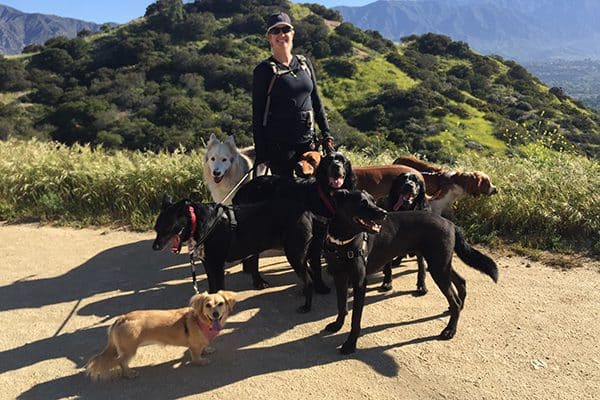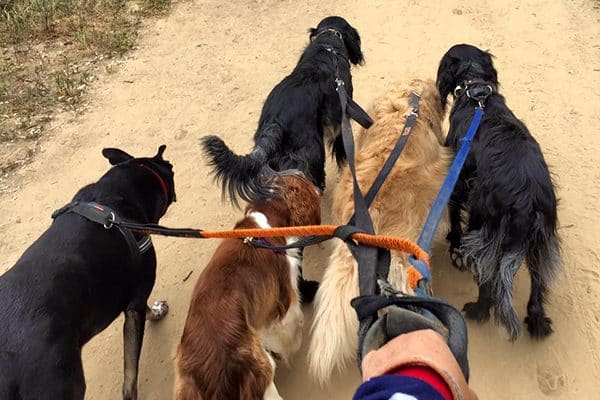Summer vacation is the best, isn’t it? That is until you realize it isn’t a trip that your adorable pup can join you on. As a dog sitter who does dog boarding in my home, I know how important it is for your four-legged family member to be safe and happy while you’re gone. I’ve outlined some nightmare situations that I’ve lived through and provide some tips on how to avoid a dog-boarding or dog-sitting disaster in the future.

Getting some exercise with the pack. Photography by Wendy Newell.
Choose the Right Dog-Boarding or Dog-Sitting Situation for Your Pup
Choose wisely where your dog stays. Home group sitting, like I do, isn’t for all pups. You have a lot of options — vet overnight services, a boarding facility (with and without interaction breaks with other dogs), an at-home dog boarding situation with a few other dogs like I do, or a dog sitter that comes to your home and focuses only on your pup.
Tips: You know your dog better than anyone else. Choose what is going to be best for his personality so he can be safe and happy while you are out enjoying summer.
Make Your Sitter or Boarder Aware of Behavioral Issues
One of my most painful trips to the ER involved my own dog. We were meeting with a Shepherd mix and his mom. During our discussion, I learned of behavioral issues that pointed to the dog being safer in a single dog home. Near the end of our visit, the guest dog became angry at my dog, Riggins. During the scuffle, a chunk of Riggins’ ear was torn off and he required a trip to the emergency vet.
Pro Tips: “Always make sure you conduct an in-home consultation with a sitter or walker before the assignment begins to ensure everyone’s comfort. Disclose to your sitter if your pet has any history of behavioral issues, such as aggression or fear toward other pets, people and places.” -Erica Kei, Online Marketing Manager at Fetch! Pet Care

Little Nikki, one of my runaways. Photography by Wendy Newell.
Prevent Running Away
I’ve had two runaway pets while dog boarding. Both had a happy ending — we found the dogs, but I was an emotional wreck and racked up an impressive number of miles and lack of sleep while walking the neighborhood nonstop. In both cases I made the owners aware of what was happening, which ruined their vacations. How can you relax on the beach when you know your sweet baby is all alone on the streets?
Tips: Always have your dog microchipped, up to date on shots and appropriately tagged and collared. Ensure the dog sitter or dog boarder has your pup’s most up-to-date medical records. Provide toys, treats and other comforts (a favorite blanket, for example) that will make your pup feel at home — and might be a handy bargaining token in case of a runaway situation.
Beware of Biting
I had a small Terrier mix who wasn’t too happy about being dumped off at the strange lady’s house. During a walk, he managed to get out of his harness and take off down a trail. With some treats, patience and the willingness to lay down in the dirt, I managed to get him back. When he got close I thought, “I have to grab him. He is going to bite me.” So, I grabbed him and, no surprise, he bit me.
Tips: Tell your sitter or boarder everything about your dog, including the tough stuff. Has he bitten or become aggressive before? Gotten loose from his leash and taken off? It’s best for dog sitters and dog boarders to know everything and prepare beforehand. Most areas require that you report dog bites and, if a doctor/policeman is involved, they are going to be recorded.
Avoid a Dog Boarder or Sitter Without Insurance
I had to take a dog to the ER because he had gotten a foxtail up his nose. Luckily, it was an easy procedure to get him fixed up, but his folks told me the last time the pup was at a sitting service he ate something toxic. The service didn’t have insurance, which meant the owners had to cover the very expensive treatment their pup needed.
A dog sitter or boarder that has insurance that covers your dog in case of emergency is a huge plus. Many sitting or boarding services have liability insurance to cover themselves, their sitters and/or their businesses, but coverage stops short of covering the guest pup. I work through rover.com (formally DogVacay), which offers premium insurance to their guests. My experience with this coverage has been extremely positive and saved guest pup parents not just financially but emotionally.
Pro Tips: “Ask for references and follow up with those references. Reputation with clients is the best way to confirm that you have made a great choice for a pet care provider.” -Carmen Rustenbeck, CEO & Founder, IBPSA
“Make sure your pet has had all of their shots and talk to your veterinarian about any additional vaccines they may need during their stay, like the Bordetella vaccine.” -Dr. Sarah Nold, staff veterinarian at Trupanion
The IBPSA (International Boarding & Pet Services Association) has a suggested list of questions to ask when choosing the best sitting or boarding situation for you pup.

Riggins, Spencer, Sissy, Asscher and Happy take me for a walk. Photography by Wendy Newell.
Here’s a helpful checklist to get your dog prepared for a sitter or boarder:
- Food information: Provide the food so your dog doesn’t get stomach upset by switching foods when he’s already a little stressed. Give exact measurements (1/3 cup) and times when your dog should be fed.
- Treats: Provide treats. Explain how many the pet sitter can give and under what circumstances.
- Medications: Prep them ahead of time to make it easier on the sitter and give specific instructions. Try putting the meds for each day in a baggie labeled for that day.
- Note any food behavior/medical issues: Does your dog steal other dogs’ food, does he gulp his food down too quickly, does he have a sensitive stomach?
- Water: Does your dog drink only filtered water? Does he drink a lot of water and needs two bowls? Ask the pet sitter to freshen at morning and at night.
- Explain all behavioral issues: Does your dog have trouble warming up to new people? Is your dog startled by loud noises? Does your dog mark in unfamiliar places? Can your dog nip if anxious?
- Sleeping: Bring along your dog’s bed/blanket and explain your dog’s typical sleep routine.
- If you are using a pet-boarding service, ask them to send photos (I call them proof of life) and texts to let you know how your pets are doing. If you have a pet sitter come to the house, ask for the same, plus invest in a pet cam. (Let your sitter know you have one.)
- Dog gear: If you are taking your dog to a service, make a list of his gear, so you remember what to bring and they remember what to give back to you.
- Information: Give them a copy of vaccinations, your veterinarian’s information and all contact information for you.
- Other: If the pet sitter is coming to the house, let them know what lights to put on when, where the air conditioner/heater is and if they are welcome to any food or drink in the house. Leave information for the television, too.
What dog-boarding or dog-sitting nightmares do you have? How do you prepare your pup when he goes to stay with a sitter or boarder? Tell us in the comments!
Read more on dog boarding and dog sitting here:
- Are These Pet Sitter Instructions Too Much?
- 10 Questions to Ask of Any Potential Pet Sitter
- 5 Ways to Help the Pet Sitter Keep Your Dog Safe
Thumbnail: Chippy shows of the yellow guest tag all my pups wear with my emergency contact info on it. If your sitter doesn’t provide one, make your own. Photography by Wendy Newell.
The post Dog-Boarding Nightmares and Tips on How to Avoid Them appeared first on Dogster.
No comments:
Post a Comment